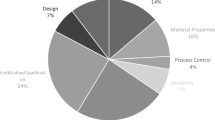Abstract
Robust design can significantly improve a producer’s competitive ability to deliver high-quality products with low development cycle time, quality loss, failure cost, and tolerance cost. However, during usage by a consumer, the functional performance of a product or some of its components may change as use time passes, leading to unexpected product failure that is usually costly in both time and money. The cost of these failures may influence the determination of optimal use time and optimal initial settings as compensation for the possible process mean changes during consumer usage. In addition to finding use time and initial settings for proper quality performance, the determination of process mean and tolerance also needs to be considered. As is known, changes in process means acquired quality loss and variability, while process tolerance has an effect on tolerance-related costs and quality loss. Because there exists a dependency among use time, initial setting of process mean, process mean, and process tolerance, these values must be determined simultaneously. Thus, in this paper, an optimization model with an acceptable reliability value is developed to minimize total cost, including quality loss, failure cost, and tolerance cost, by determining optimal use time, initial settings, process mean, and process tolerance, simultaneously. Applications of single and multiple components are presented to explain the proposed models. Finally, sensitivity analysis and model discussions on some decision variables are performed.
Similar content being viewed by others
References
Al-Fawzan MA, Rahim MA (2001) Optimal control of a deteriorating process with a quadratic loss function. Qual Reliab Eng Int 17:459–466
Brooke A, Kendrick D, Meeraus A, Raman R (1998) GAMS: a user’s guide. GAMS Development Corporation, Washington, D.C., USA
Chase KW, Greenwood WH, Loosli BG, Haugland LF (1990) Least cost tolerance allocation for mechanical assemblies with automated process selection. Manuf Rev 3(1):49–59
Drezner Z, Wesolowsky GO (1989) Optimal control of a linear trend process with quadratic loss. IIE Trans 21:66–72
Gibra TN (1967) Optimal control of process subject to linear trends. J Ind Eng 18(1):35–41
Irani SA, Mittal RO, Lehtihet EA (1989) Tolerance chart optimization. Int J Prod Res 27(9):1531–1552
Jeang A, Yang K (1992) Optimal tool replacement with nondecreasing tool wear. Int J Prod Res 30(2):299–314
Jeang A (1996) Tolerance chart balancing for machining process planning. Qual Reliab Eng Int 12:355–364
Jeang A (2001) Combined parameter and tolerance design optimization with quality and cost reduction. Int J Prod Res 39(5):923–952
Jeang A, Tsai SW, Li HC, Hsien CK (2002) A computer model for time-based tolerance design with response surface methodology. Int J Comput Integr Manuf 15(2):97–108
Jeang A, Chung CP, Hsieh CK (2005) Simultaneous process mean and process tolerance determination with asymmetric loss function. Int J Adv Manuf Technol, published online 30 December, DOI 1007/s00170-005-0250-3
Jeang A, Chen T, Li HC, Liang F (2006) Simultaneous process mean and process tolerance determination with adjustment and compensation for precision manufacturing. Int J Adv Manuf Technol, published online 10 June, DOI 10.1007/s00170-006-0542-2
Kackar RN (1985) Off-line quality control, parameter design, and the Taguchi method. J Qual Technol 17(4):176–198
Kotz S, Johnson NL (1993) Process capability indices. Chapman & Hall, London
Mittag HJ, Rinne H (1993) Statistical methods of quality assurance. Chapman & Hall, London
Ngoi BKA (1992) Applying linear programming to tolerance chart balancing. Int J Adv Manuf Technol 7(2):187–192
Ngoi BKA, Teck OC (1993) A complete tolerance charting system. Int J Prod Res 31(2):453–469
Ngoi BKA (1993) A matrix approach to tolerance charting. Int J Adv Manuf Technol 8(3):175–181
Ngoi BKA, Ong CT (1996) Optimum assembly using a component dimensioning method. Int J Adv Manuf Technol 11:172–178
Phadke MS (1989) Quality engineering using robust design. Prentice Hall, Englewood Cliffs, New Jersey
Rahim MA, Tuffaha F (2004) Integrated model for determining the optimal initial setting of the process mean and the optimal production run assuming quadratic loss functions. Int J Prod Res 42(16):3281–3300
Sheikh AK, Raouf A, Sekerdey UA, Younas M (1999) Optimal tool replacement and resetting strategies in automated manufacturing systems. Int J Prod Res 37(4):917–937
Taguchi G, Elsayed E, Hsiang T (1989) Quality engineering in production systems. McGraw Hill, New York
Wu Z, Elmaraghy WH, Elmaraghy HA (1988) Evaluation of cost-tolerance algorithm for design tolerance analysis and synthesis. Manuf Rev 1(3):168–179
Zhang HC, Hug HE (1982) Tolerancing techniques: the state of art. Int J Prod Res 30(9):2111–2135
Author information
Authors and Affiliations
Corresponding author
Rights and permissions
About this article
Cite this article
Jeang, A., Chung, CP. Process mean, process tolerance, and use time determination for product life application under deteriorating process. Int J Adv Manuf Technol 36, 97–113 (2008). https://doi.org/10.1007/s00170-006-0814-x
Received:
Accepted:
Published:
Issue Date:
DOI: https://doi.org/10.1007/s00170-006-0814-x




